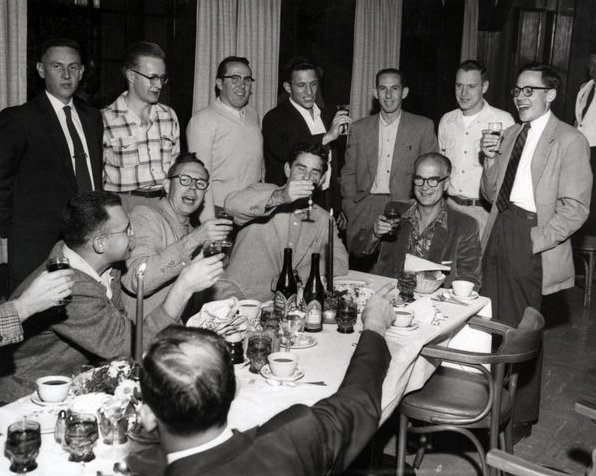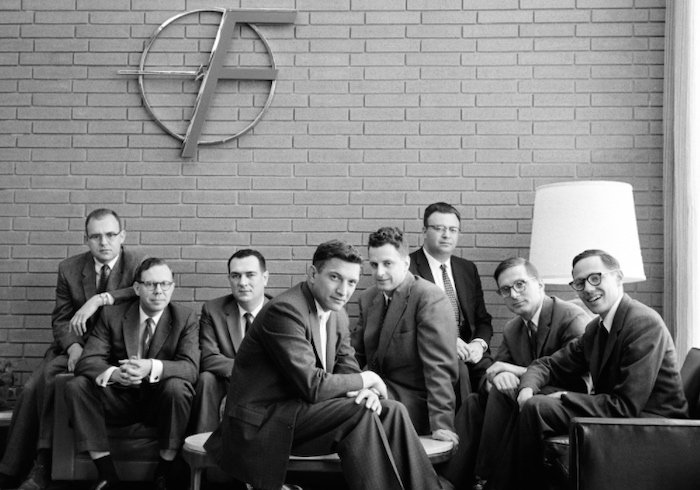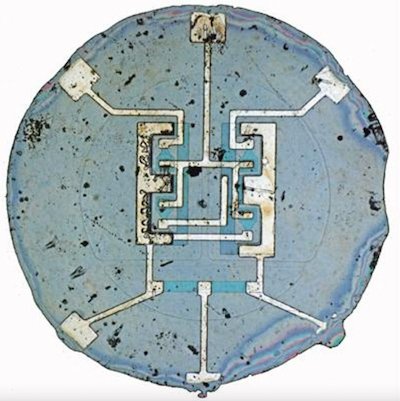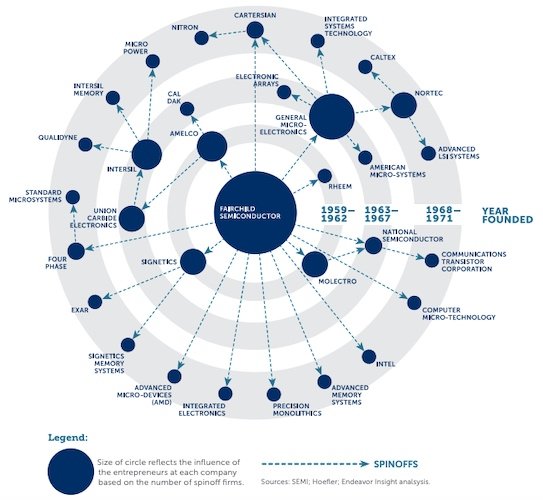In 1955, Shockley Semiconductor had everything going for it. Headed by a Nobel laureate and home to the industry’s brightest, Shockley Semiconductor was the first high-tech company in what would become Silicon Valley. But for many Shockley employees, the glamor of working under a co-creator of the first transistor quickly lost its luster.

William Shockley celebrates his part in the 1956 Nobel Prize alongside his employees, including Gordon Moore, Robert Noyce, Sheldon Roberts, and Jay Last. Image used courtesy of Computer History
While specialized semiconductor knowledge was notoriously hard to come by in the 1950s, researchers under William Shockley’s watch grappled with a myriad of challenges—including micro-management, impatience, and skepticism. Shockley’s paranoia of internal mutiny even prompted detective-led investigations and threats of lie detector testing.
Furthermore, employees saw Shockley as an incompetent businessman. He maintained a poor rapport with ley investor Arnold Beckman, and his outbursts caused mounting friction. Massive research costs stemming from Shockley’s propensity to project hop were also threatening the company’s future.
The resulting environment within Shockley Semiconductor’s walls was contemptuous, stressful, and stifling. The bubble was destined to burst at any moment. What would happen next would give rise to perhaps the most influential tech octet of the late 1950s onward.
The "Traitorous Eight" Defect—and a Semiconductor Star is Born
By 1957, frustrations had finally come to a head. In the Redwood Room of the Clift Hotel, eight young scientists—including Gordon Moore, Robert Noyce, Julius Blank, Victor Grinich, Jean Hoerni, Eugene Kleiner, Jay Last, and Sheldon Roberts—met to discuss how they might defect from Shockley Semiconductor and form their own company with MIT graduate Robert Noyce at the helm. This summit of brilliant minds (between the ages of 26 and 33) was the first step in building a company that would someday father more than 2,000 spin-out tech companies.
The group possessed every ingredient needed to succeed on paper. Six of them held PhDs. Noyce was a semiconductor researcher, while Grinich was well-versed in electronics. Hoerni brought strong scientific knowledge and managerial skills to the table. Though not all were seasoned professionals, their academic training and apprenticeships under Shockley held immense promise. Finally, their shared contempt, vision, and youthful exuberance propelled them to leave Shockley and create their own company.

The "traitorous eight." Image used courtesy of Intel and PBS
A key challenge the eight faced was convincing others. Geography proved to be a formidable foe in their search for financiers since their west coast locale was largely devoid of bankers and investors. These individuals lived out east, and meetings were therefore much harder to conduct.
The eight men were finally able to connect with experienced bankers from Boston, Arthur Rock and Bud Coyle, who helped them enlist investors. Still, the group of scientists had to navigate a world largely devoid of venture capitalists as we’ve come to know them.
Rock and Coyle approached more than 30 potential companies before one—Fairchild Camera and Instrument—stepped forward. Sherman Fairchild, after whom the company was named, handed them a $1.4 million loan and a $3 million buyout option. This sparked the rise of Fairchild Semiconductor, which would forever change the semiconductor industry and the electrical-engineering field thereafter.
Fairchild's Rise to Prominence
After securing office space, the group had taken their first major step toward forming a business. Next, Fairchild began hiring a diverse workforce within the Santa Clara Valley—enlisting veterans of the region’s canning industry. This was a far cry from the intimate group that previously set up shop in Grinrich’s home garage.
The young startup quickly found its legs. Teams rapidly created their own workspaces and core components. They were tasked with winding diffusion tubes, growing silicon crystals, and creating manufacturing processes from near scratch. The support from Hoerni (developer of the planar process), Kleiner (administrator of Fairchild), and others was integral in making fast breakthroughs.
From these, Fairchild made its biggest contribution to engineering history: the integrated circuit. Though Texas Instruments has been credited with co-discovering this innovation, Fairchild’s planar process unlocked mass production. Etching every transistor, capacitor, and resistor necessary to build a functioning chip onto one unified surface proved extremely useful. This consolidation enabled much higher yields. It also provided a blueprint for the entire industry. Handcrafting quickly gave way to batch production.

The first IC out of Fairchild in 1960 included four transistors. Image used courtesy of Computer History
While semiconductor enthusiasts worldwide rejoiced, not all were thrilled with Fairchild’s progress. Angered by a perceived betrayal and his new rival’s success, William Shockley lashed out by dubbing the octet the “traitorous eight.” Tensions were exacerbated by Fairchild’s location—a cozy 12 blocks away from Shockley’s facility. The neighboring towns of Palo Alto and Mountain View were quite undeveloped at that time. Each company’s presence resonated that much more, while these early tech players competed for local talent.
Additionally, Shockley Semiconductor never recovered after the eight’s departure. Shockley’s latter creation—the four-layer diode—was a technical success, yet never became commercially viable in the face of integrated circuits. Despite a string of small (non-lucrative) successes, Clevite Transistor acquired Shockley Semiconductor Laboratory in 1960.
Fairchild Revolutionizes the Semiconductor Industry
Robert Noyce is credited with inventing the first monolithic integrated circuit (IC). Improving upon the insulation from Hoerni's planar process technology, Noyce discovered a method of connecting IC components called aluminum metallization. Fairchild then used the ideas of Noyce and Hoerni to develop the first operational semiconductor integrated circuit.
Meanwhile, Texas Instruments (TI) held a patent for Jack Kilby's invention of the hybrid IC, built using the patented principle of integration. TI started a patent war with Fairchild, which was eventually settled with a cross-licensing agreement in 1966. While there is still some dispute on who invented the integrated circuit, most institutions jointly credit both Kilby and Noyce as the IC's inventors, though they worked separately.
Fairchild made numerous other contributions to the semiconductor realm following its initial success. The decades following its founding were punctuated with developments both small and large:
- The resistor-transistor logic IC, which helped power the Apollo Space Program
- The charge-coupled device and its 8-bit microprocessor, the F8
- The Channel F video game system, which laid the foundations for Atari and Nintendo’s own
The Dissolution of Fairchild
Fairchild’s own fate changed as the years passed. The company ran into financial hardship in the late 1960s—facing new competition from area startups and falling stock prices as a result. Key departures from Noyce and Moore hurt Fairchild from 1967 onward. This duo formed Intel, which would become one of Fairchild’s biggest competitors.

Robert Noyce (left) and Gordon Moore in front of Intel's Santa Clara office in 1970. Image used courtesy of Intel and Encyclopedia Brittanica [CC BY-SA 2.0]
Fairchild sold off business units that had become liabilities and continued to close various locations throughout the 1970s. The company faded from the commercial spotlight after its 1987 acquisition by National Semiconductor. This $200 million sale (over $471 million in today’s dollars) brought Fairchild under a new umbrella.
However, the company did grow notably in the 90s and early 2000s through a series of company purchases. It captured a greater share of the market and renewed its chipmaking duties. Unfortunately, the 2010s were a turning point for Fairchild. The company was ultimately bought and absorbed by ON Semiconductor (now onsemi) in 2016. As a brand, it soon ceased to exist.
Fairchild revolutionized the semiconductor industry, prompting the widespread adoption of silicon materials in lieu of germanium. It also helped thrust MOSFET technology into the limelight. Growing from a collective of eight upstarts, the company eventually amassed a workforce exceeding 11,000.
The Lasting Legacy of Silicon Valley's Founding Fathers
While Shockley Semiconductor was the technical founding member of Silicon Valley, Fairchild was by far the most influential. Because the company was the originator of many core technologies used today, it became a critical jumping-off point for employees seeking to branch out.
Fairchild—along with its thousands of subsequent "Fairchildren"—have left an undeniable mark on Silicon Valley and beyond. Intel, AMD, Xilinx, Altera, LSI Logic, and National Semiconductor are some notable names on this list. Noyce’s own mentorships created a domino effect; his influence on Steve Jobs, Sergey Brin, and Larry Page would ultimately help shape the founding of Apple and Google.

In just 12 years from its inception, Fairchild Semiconductor had already seen 31 spin-out companies. Image used courtesy of Endeavor Insights
The traitorous eight, despite their scandalous namesake, have earned a positive industry reputation. Its members have branched off to teach, consult, found companies, and even form prominent venture capital firms. For instance, many tech companies in the Valley, including Amazon, owe their initial success to Kleiner’s funding. Gordon Moore, father of Moore's law and one of four living members of the group, remained in senior positions at Intel until 1997 when he was named Chairman Emeritus of the corporation. He also formed a philanthropic foundation with his wife.
Grinich went on to elucidate integrated circuits in academia, creating the first textbook on the subject. He also later founded several companies specializing in RFID tags. Blank continued on to found financial firm Xicor, and Hoerni found several companies of his own, including Amelco (acquired by Microchip) and Intersil (acquired by Renesas). Last, Roberts, and Kleiner also worked alongside Hoerni at Amelco.
Although the traitorous eight’s remaining members admittedly don’t embrace their nickname, they have become accustomed to it. The group even claims that it tried to reconcile with Shockley, though those attempts seemed largely fruitless. Throughout their lives, however, their collective efforts in engineering have elevated them to legendary status among peers and contemporaries.
Have you worked at a company that traces its lineage back to the eight founders of Fairchild? Tell us how the feats of these early Silicon Valley engineers have impacted your lived experience as a modern-day EE.
